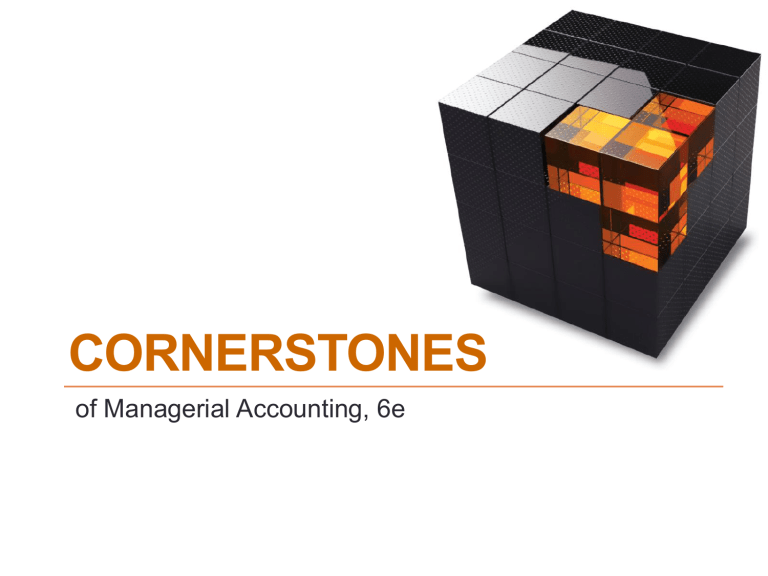
CORNERSTONES
of Managerial Accounting, 6e
© 2016 Cengage Learning. All Rights Reserved. May not be copied, scanned, or duplicated, in whole or in part, except for use as permitted in a
license distributed with a certain product or service or otherwise on a password-protected website for classroom use.
CHAPTER 1:
INTRODUCTION TO
MANAGERIAL ACCOUNTING
Cornerstones of Managerial
Accounting, 6e
© 2016 Cengage Learning. All Rights Reserved. May not be copied, scanned, or duplicated, in whole or in part, except for use as permitted in a
license distributed with a certain product or service or otherwise on a password-protected website for classroom use.
The Meaning of Managerial
Accounting
Providing accounting information for a company’s
internal users.
Managerial accounting is not bound by generally
accepted accounting principles (GAAP).
Managerial accounting has three broad
objectives:
LO-1
© 2016 Cengage Learning. All Rights Reserved. May not be copied, scanned, or duplicated, in whole or in part, except for use as permitted in a
license distributed with a certain product or service or otherwise on a password-protected website for classroom use.
The Meaning of Managerial
Accounting (cont.)
1
2
• To provide information for planning the organization’s
actions.
• To provide information for controlling the organization’s
actions.
• To provide information for making effective decisions.
3
LO-1
© 2016 Cengage Learning. All Rights Reserved. May not be copied, scanned, or duplicated, in whole or in part, except for use as permitted in a
license distributed with a certain product or service or otherwise on a password-protected website for classroom use.
Planning
The detailed formulation of action to achieve a
particular end is the management activity called
planning.
Example
Setting objectives
Improve Quality
Identifying methods to
achieve those objectives
Supplier Evaluation
Program
LO-1
© 2016 Cengage Learning. All Rights Reserved. May not be copied, scanned, or duplicated, in whole or in part, except for use as permitted in a
license distributed with a certain product or service or otherwise on a password-protected website for classroom use.
Controlling
The managerial activity of monitoring a plan’s
implementation and taking corrective action as
needed is controlling.
Compare
Actual
Performance
Expected
Performance
LO-1
© 2016 Cengage Learning. All Rights Reserved. May not be copied, scanned, or duplicated, in whole or in part, except for use as permitted in a
license distributed with a certain product or service or otherwise on a password-protected website for classroom use.
Decision Making
The process of choosing among competing
alternatives is called decision making.
????
????
??
LO-1
© 2016 Cengage Learning. All Rights Reserved. May not be copied, scanned, or duplicated, in whole or in part, except for use as permitted in a
license distributed with a certain product or service or otherwise on a password-protected website for classroom use.
Financial Accounting and
Managerial Accounting
Financial Accounting provides information for
external users:
Investors, creditors, customers, suppliers, government
agencies, and labor unions.
Financial accounting is historical:
Investment decisions, stewardship evaluation,
monitoring activity, and regulatory measures.
LO-2
© 2016 Cengage Learning. All Rights Reserved. May not be copied, scanned, or duplicated, in whole or in part, except for use as permitted in a
license distributed with a certain product or service or otherwise on a password-protected website for classroom use.
Financial Accounting and
Managerial Accounting (cont.)
Financial statements must follow rules defined by:
Securities and Exchange Commission (SEC)
Financial Accounting Standards Board (FASB)
International Accounting Standards Board (IASB).
Managerial Accounting produces information for
internal users, such as managers, executives,
and workers.
LO-2
© 2016 Cengage Learning. All Rights Reserved. May not be copied, scanned, or duplicated, in whole or in part, except for use as permitted in a
license distributed with a certain product or service or otherwise on a password-protected website for classroom use.
Financial Accounting and
Managerial Accounting (cont.)
Managerial accounting
Financial accounting
Internal accounting
External accounting
Managerial Accounting identifies, collects,
measures, classifies, and reports financial and
nonfinancial information to internal users in
planning, controlling, and decision making.
LO-2
© 2016 Cengage Learning. All Rights Reserved. May not be copied, scanned, or duplicated, in whole or in part, except for use as permitted in a
license distributed with a certain product or service or otherwise on a password-protected website for classroom use.
Comparison of Financial and
Managerial Accounting
Financial Accounting
Managerial Accounting
Externally focused
Internally focused
Must follow externally imposed rules
No mandatory rules
Objective financial information
Financial and information; subjective
information possible nonfinancial
Historical orientation
Emphasis on the future
Information about the firm as a whole
Internal evaluation and decisions
based on very detailed information
More self-contained
Broad, multidisciplinary
LO-2
© 2016 Cengage Learning. All Rights Reserved. May not be copied, scanned, or duplicated, in whole or in part, except for use as permitted in a
license distributed with a certain product or service or otherwise on a password-protected website for classroom use.
Current Focus of Managerial
Accounting
The business environment in which companies
operate has changed
Effective managerial accounting systems provide
information that helps improve companies’
planning, control, and decision-making activities.
LO-3
© 2016 Cengage Learning. All Rights Reserved. May not be copied, scanned, or duplicated, in whole or in part, except for use as permitted in a
license distributed with a certain product or service or otherwise on a password-protected website for classroom use.
Current Focus of Managerial
Accounting (cont.)
Important uses of managerial accounting:
1. New methods of estimating product and service
cost and profitability
2. Understanding customer orientation
3. Evaluating the business from a cross-functional
perspective
4. Providing information useful in improving total
quality.
LO-3
© 2016 Cengage Learning. All Rights Reserved. May not be copied, scanned, or duplicated, in whole or in part, except for use as permitted in a
license distributed with a certain product or service or otherwise on a password-protected website for classroom use.
New Methods of Costing Products
and Services
Today’s companies need focused, accurate
information on the cost of products and services
produced.
Activity-based costing (ABC) is a more detailed approach
to determine the cost of goods and services.
ABC improves costing accuracy by emphasizing the
cost of the many activities or tasks that must be done to
produce a product or service.
LO-3
© 2016 Cengage Learning. All Rights Reserved. May not be copied, scanned, or duplicated, in whole or in part, except for use as permitted in a
license distributed with a certain product or service or otherwise on a password-protected website for classroom use.
New Methods of Costing Products
and Services (cont.)
Process-value analysis focuses on the way in which
companies create value for customers.
Find ways to perform necessary activities more
efficiently and eliminate those that do not create
customer value.
LO-3
© 2016 Cengage Learning. All Rights Reserved. May not be copied, scanned, or duplicated, in whole or in part, except for use as permitted in a
license distributed with a certain product or service or otherwise on a password-protected website for classroom use.
Value Chain
Successful pursuit of cost leadership and
strategies
The value chain is the set of activities required to
design, develop, produce, market, and deliver
products and services, and provide support
services to customers.
LO-3
© 2016 Cengage Learning. All Rights Reserved. May not be copied, scanned, or duplicated, in whole or in part, except for use as permitted in a
license distributed with a certain product or service or otherwise on a password-protected website for classroom use.
Value Chain (cont.)
LO-3
© 2016 Cengage Learning. All Rights Reserved. May not be copied, scanned, or duplicated, in whole or in part, except for use as permitted in a
license distributed with a certain product or service or otherwise on a password-protected website for classroom use.
The Role of the Managerial
Accountant
The role of managerial accountants is one of
support.
Assist those who are responsible for carrying out
an organization’s basic objectives.
Positions that have direct responsibility for the
basic objectives of an organization are line
positions.
LO-4
© 2016 Cengage Learning. All Rights Reserved. May not be copied, scanned, or duplicated, in whole or in part, except for use as permitted in a
license distributed with a certain product or service or otherwise on a password-protected website for classroom use.
The Role of the Managerial
Accountant (cont.)
Positions that are supportive in nature and have
only indirect responsibility for an organization’s
basic objectives are staff positions.
The controller supervises all accounting
functions and reports directly to the general
manager and chief operating officer.
In larger companies, the controller is separate
from the treasury department. The treasurer is
responsible for the finance function.
LO-4
© 2016 Cengage Learning. All Rights Reserved. May not be copied, scanned, or duplicated, in whole or in part, except for use as permitted in a
license distributed with a certain product or service or otherwise on a password-protected website for classroom use.
Managerial Accounting and Ethical
Conduct
The objective of profit maximization should be
constrained by the requirement that profits be
achieved through legal and ethical means.
Ethical behavior involves choosing actions that
are right, proper, and just.
LO-5
© 2016 Cengage Learning. All Rights Reserved. May not be copied, scanned, or duplicated, in whole or in part, except for use as permitted in a
license distributed with a certain product or service or otherwise on a password-protected website for classroom use.
Managerial Accounting and Ethical
Conduct (cont.)
Behavior can be right or wrong; it can be proper
or improper; and the decisions we make can be
fair or unfair.
Companies in business for the long term find that
it pays to treat all with honesty and loyalty.
LO-5
© 2016 Cengage Learning. All Rights Reserved. May not be copied, scanned, or duplicated, in whole or in part, except for use as permitted in a
license distributed with a certain product or service or otherwise on a password-protected website for classroom use.
Certification
Three major forms of certification for managerial
accountants:
Certificate in Management Accounting
Certificate in Public Accounting
Certificate in Internal Auditing
Each certification offers particular advantages to
a managerial accountant.
All three certifications offer proof of achievement
at a minimum level of professional competence.
LO-6
© 2016 Cengage Learning. All Rights Reserved. May not be copied, scanned, or duplicated, in whole or in part, except for use as permitted in a
license distributed with a certain product or service or otherwise on a password-protected website for classroom use.
Additional slides
© 2016 Cengage Learning. All Rights Reserved. May not be copied, scanned, or duplicated, in whole or in part, except for use as permitted in a
license distributed with a certain product or service or otherwise on a password-protected website for classroom use.
Comparison of Financial and
Managerial Accounting
Financial Accounting
Managerial Accounting
External persons who
make financial decisions
Managers who plan for
and control an organization
Historical perspective
Future emphasis
3. Verifiability
versus relevance
Emphasis on
verifiability
Emphasis on relevance
for planning and control
4. Precision versus
timeliness
Emphasis on
precision
Emphasis on
timeliness
5. Subject
Primary focus is on
the whole organization
Focuses on segments
of an organization
6. GAAP
Must follow GAAP
and prescribed formats
Need not follow GAAP
or any prescribed format
Mandatory for
external reports
Not
Mandatory
1. Users
2. Time focus
7. Requirement
Organizational Structure
Decentralization is the delegation of decisionmaking authority throughout an organization.
Corporate Organization Chart
Board of Directors
President
Purchasing
Personnel
Vice President
Operations
Chief Financial
Officer
Treasurer
Controller
Line and Staff Relationships
Line positions are directly
related to achievement of
the basic objectives of an
organization.
Example: Production
supervisors in a
manufacturing plant.
Staff positions support
and assist line positions.
Example: Cost accountants
in the manufacturing plant.
Code of Conduct for
Management Accountants
The Institute of Management Accountant’s (IMA)
Standards of Ethical Conduct for Practitioners
of Management Accounting and Financial
Management have two major parts,
which offer guidelines for:
Ethical behavior.
Resolution for an ethical conflict.
IMA Guidelines for Ethical Behavior
Recognize and
communicate professional
limitations that preclude
responsible judgment.
Maintain
professional
competence.
Competence
Provide accurate, clear,
concise, and timely decision
support information.
Follow applicable
laws, regulations
and standards.
IMA Guidelines for Ethical Behavior
Do not disclose confidential
information unless legally
obligated to do so.
Do not use
confidential
information for
unethical or illegal
advantage.
Confidentiality
Ensure that subordinates do
not disclose confidential
information.
IMA Guidelines for Ethical Behavior
Mitigate conflicts of
interest and advise others
of potential conflicts.
Refrain from
conduct that
would prejudice
carrying out
duties ethically.
Integrity
Abstain from activities that
might discredit the
profession.
IMA Guidelines for Ethical Behavior
Communicate information
fairly and objectively.
Credibility
Disclose all relevant
information that could
influence a user’s
understanding of reports
and recommendations.
Disclose delays or
deficiencies in information
timeliness, processing, or
internal controls.
Company Codes of Conduct
Broad-based statements of a
company’s responsibilities to:
Employees
Customers
Suppliers
And to the communities in
which the company operates.






